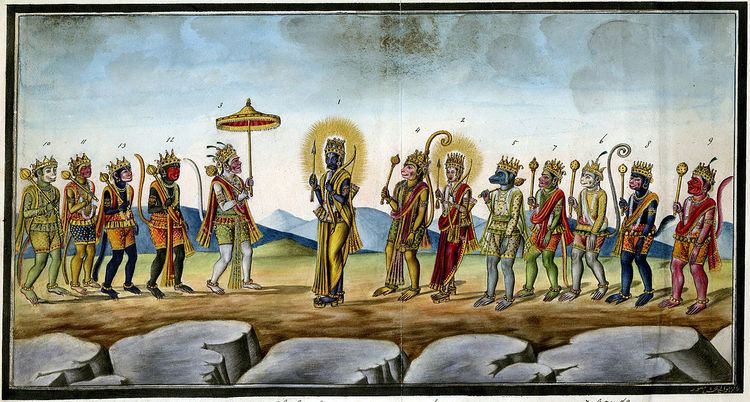 | ||
Vānara (Sanskrit: वानर) refers to a group of people living in forests in the Hindu epic the Ramayana and its various versions. In the Ramayana, the Vanaras help Rama defeat Ravana.
Contents
Identification
There are three main theories about the etymology of the word "Vanara":
Although the word Vanara has come to mean "monkey" over the years and the Vanaras are depicted as monkeys in the popular art, their exact identity is not clear. Unlike other exotic creatures such as the rakshasas, the Vanaras do not have a precursor in the Vedic literature. The Ramayana presents them as humans with reference to their speech, clothing, habitations, funerals, consecrations etc. It also describes their monkey-like characteristics such as their leaping, hair, fur and a tail.
According to one theory, the Vanaras are strictly mythological creatures. This is based on their supernatural abilities, as well as descriptions of Brahma commanding other deities to either bear Vanara offspring or incarnate as Vanaras to help Rama in his mission. The Jain re-tellings of Ramayana describe them as a clan of the supernatural beings called the Vidyadharas; the flag of this clan bears monkeys as emblems.
Another theory identifies the Vanaras with the tribal people, who dwelled in the forests and used monkey totems. G. Ramdas, based on Ravana's reference to the Vanaras' tail as an ornament, infers that the "tail" was actually an appendage in the dress worn by the men of the Savara tribe. (The female Vanaras are not described as having a tail.) According to this theory, the non-human characteristics of the Vanaras may be considered artistic imagination. In Sri Lanka, the word "Vanara" has been used to describe the Nittaewos mentioned in the Vedda legends.
In the Ramayana
Vanaras are created by Brahma to help Rama in battle against Ravana. They are powerful and have many godly traits. Taking Brahma's orders, the gods began to parent sons in the semblance of monkeys (Ramayana 1.17.8). The Vanaras took birth in bears and monkeys attaining the shape and valor of the gods and goddesses who created them (Ramayana 1.17.17-18). After Vanaras were created they began to organize into armies and spread across the forests, although some, including Vali, Sugriva, and Hanuman, stayed near Mount Riskshavat.
According to the Ramayana, the Vanaras lived primarily in the region of Kishkindha (identified with parts of present-day Karnataka, Andhra Pradesh & Maharashtra). Rama first met them in Dandaka Forest, during his search for Sita. An army of Vanaras helped Rama in his search for Sita, and also in battle against Ravana, Sita's abductor. Nala and Nila built a bridge over the ocean so that Rama and the army could cross to Lanka. As described in the epic, the characteristics of the Vanara include being amusing, childish, mildly irritating, badgering, hyperactive, adventurous, bluntly honest, loyal, courageous, and kind.
Other texts
The Vanaras also appear in other texts, including Mahabharata. The epic Mahabharata describes them as forest-dwelling, and mentions their being encountered by Sahadeva, a Pandava general who led a military campaign to south India.
Shapeshifting
In the Ramayana, the Vanara Hanuman changes shape several times. For example, while he searches for the kidnapped Sita in Ravana's palaces on Lanka, he contracts himself to the size of a cat, so that he will not be detected by the enemy. Later on, he takes on the size of a mountain, blazing with radiance, to show his true power to Sita.
